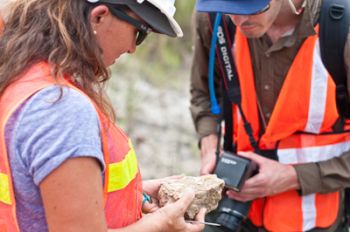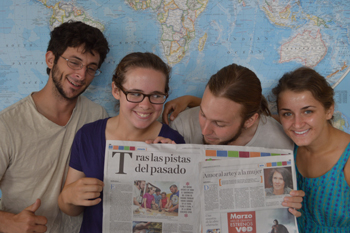By Dawn Mitchell | PCP PIRE and GABI RET Project Assistant
While the main objective of PCP PIRE was to research the ancient biodiversity of the Neotropics, sharing those discoveries with the general public through education and outreach comprised a significant component of our overall efforts. One highly successful product of this goal was the PCPPIRETeach program. In 2012 and 2013, PCP PIRE received funding to bring two cohorts of K-12 science teachers to Panama to conduct paleontological fieldwork and learn relevant scientific concepts through interactions with professional scientists. Based on the success of PCPPIRETeach, we submitted a grant proposal to support a new program focusing on teacher-scientist collaborations and field experience and, thus, in mid-2014 GABI RET (Great American Biotic Interchange – Research Experience for Teachers) was born. Teachers from PCPPIRETeach were subsumed into GABI RET to build a community of educators that shared this unique experience, and PCP PIRE participants continue to collaborate with GABI RET. For example, after their internship, several field interns who worked with GABI RET teachers in the field went on to conduct classroom STEM role model visits with them, inspiring the next generation of scientists and gaining experience explaining their research and other science concepts to K-12 students.

In other K-12 outreach efforts, PCP PIRE participants, along with two high school teachers and members of the University of Florida Center for Precollegiate Education and Training (CPET), developed a new K-12 curriculum that uses the evolution of horses in North America to teach concepts related to climate change, paleoecology, and evolutionary relationships. The three-lesson curriculum utilizes 3-D printed models of horse teeth and is now in a field testing phase that includes 23 teachers from 9 states with nearly 1500 students.
Another outreach project supported by PCP PIRE was the development of exhibits for the BioMuseo in Panama, which opened its doors in October 2014. The museum boasts beautifully designed exhibits that highlight Panama’s biodiversity as well as its complex but fascinating geologic history. PCP PIRE participants provided background information for some exhibits as well as casts of significant fossils from the Panama Canal and its surrounding areas. In addition, a temporary exhibit dubbed “Giant Sharks and Tiny Camels” features PCP PIRE’s field activities and research. Eight of the PCP PIRE field interns, over the course of a year, shared their geological and paleontological knowledge during collaborations with the docents. This collaboration resulted in a visitor-friendly version of Panama’s dynamic biological and geological history. Other interns helped at the BioMuseo by preparing specimens for display.

The field interns’ work did not go unnoticed by the local media. Panamanian news outlets featured the interns several times; they were on the front cover of the newspaper La Prensa, the radio talk show Momentos con Luissis and the focus of a television spot on TVN Noticias.
In order to share their discoveries and activities on a wider scale, PCP PIRE employed several online platforms and social media. The PCP PIRE website hosted most of the information related to the project. The Flickr page holds thousands of pictures that participants took over the years of all the sights that were seen during the course of the project. Facebook and Twitter were used to share short updates with participants and other interested parties, and eNewsletters were distributed to detail important developments related to the project. The WordPress blog presented field interns in Panama with a more accessible way to describe their experience and was similarly used by the museum interns working at FLMNH.
The products of PCP PIRE’s education and outreach goals have already made a significant impact on many, and the effects are sure to be long-lasting and far-reaching. Our involvement with K-12 teachers—through collaboration in the development of lesson plans and providing fossil material and access to scientists—will continue to have influence, as each teacher then goes on to impact dozens of children. In addition, by getting our interns involved in outreach and education opportunities, we have shown these young scientists the importance of giving back to their communities by making science accessible. We look forward to watching PCP PIRE’s participants and their discoveries change how science is taught and perceived.
Por Dawn Mitchell | Ayudante de lps proyectos PCP PIRE y GABI RET
Aunque la meta principal de PCP PIRE era investigar la biodiversidad antigua de los neotrópicos, el compartir de esos descubrimientos con el público general por educación era una gran parte de nuestros esfuerzos. Un gran éxito que contribuyó a esa meta era el programa PCPPIRETeach. En 2012 y 2013, PCP PIRE recibió los fondos necesarios para llevar dos grupos de maestros de ciencia de los grados K-12 a Panamá para hacer trabajo de campo y aprender conceptos científicos pertinentes por interactuar con científicos profesionales. Con el éxito de PCPPIRETeach, entregamos un propósito para apoyar un nuevo programa que se enfocaría en la colaboración entre maestros y científicos y el trabajo de campo, y entonces, el programa GABI RET se nació (Gran Intercambio Biótico Americano- Experiencia de Investigación para Educadores). Los participantes de PCPPIRETeach se juntaron con GABI RET para formar una comunidad de educadores que comparten la experiencia única de ir a Panamá, y PCP PIRE continúa a trabajar con GABI RET. Por ejemplo, al fin de sus pasantías, unos becarios de campo de PCP PIRE, quien trabajaban con los maestros de GABI RET en el campo, visitaron a las clases de sus compañeros para actuar como modelos de seguir, inspirando una nueva generación de científicos y ganando la experiencia de explicar sus investigaciones y otros conceptos científicos a estudiantes K-12.

Como otro programa para estudiantes K-12, participantes de PCP PIRE, con dos profesores de colegio y unos miembros de la Facultad de Educación y Formación Pre-Universidad (CPET) de la Universidad de Florida (UF), crearon un programa de lecciones nuevo que usa la evolución de caballos norteamericanos para enseñar los conceptos del cambio de clima, la paleo-ecología, y las relaciones evolucionarias. El programa de tres lecciones utiliza modelos de 3D de dientes fosilizadas y ahora está en una fase de probar, que incluye 23 profesores de 9 estados, con casi 1500 estudiantes.
Otro proyecto de educación apoyado por PCP PIRE era el desarrollo de exhibiciones para el BioMuseo de Panamá, que se abrió en octubre de 2014. El museo muestra exhibiciones con diseños bellos que subrayan la biodiversidad de Panamá además de su historia geológica compleja y fascinante. Los participantes de PCP PIRE proveyeron información de fondo para unas exhibiciones y también copias de yeso de fósiles importantes del canal de Panamá. Además, una exhibición temporánea nombrado “Tiburones gigantes y camellos diminutos” mostró el trabajo de campo y las investigaciones de PCP PIRE. Ocho de nuestros becarios de campo, durante un año, compartieron su conocimiento geológico y paleontológico para colaborar con los docentes del museo. Ésta colaboración resultó en una versión de la historia dinámica biológica y geológica de Panamá ideada para los visitantes. Otros becarios de PCP PIRE ayudaron el BioMuseo por preparar los especímenes para exhibición.

El trabajo de los becarios no fue ignorado por los medios de comunicación locales. Los becarios fueron destacados varias veces; estuvieron en la portada del periódico La Prensa, el programa de radio Momentos con Luissis, y estaban en una noticia de TVN Noticias.
Para compartir nuestros descubrimientos y actividades en amplitud más grande, PCP PIRE utilizaba muchos medios de comunicación sociales en Internet. El sitio web de PCP PIRE contiene la mayoría de la información relacionada con el proyecto. Nuestra página de Flickr tiene miles de fotos sacadas por participantes durante los seis años del proyecto. Facebook y Twitter eran usados para compartir noticias cortas, y los eNewsletter fueron distribuidos para detallar desarrollos importantes del proyecto. El blog en WordPress creado por los becarios de campo en Panamá y los de museo en Florida les dieron una manera de describir sus experiencias.
Los productos de las metas de educación de PCP PIRE ya han hecho un impacto fuerte a muchas personas, y estamos seguros que los efectos durarán mucho tiempo. Nuestro trabajo con maestros de K-12 – por colaboración para desarrollar lecciones y por proveyéndoles con fósiles y acceso a científicos- continuará tener influencia, porque cada maestro influye a docenas de niños. Además, por incluir los becarios en nuestros programa de educación, hemos mostrado a estos científicos jóvenes la importancia de reciprocación con la comunidad por hacer la ciencia accesible a todos. Anticipamos mirar los participantes de PCP PIRE y sus descubrimientos cambiando como la ciencia es enseñada y percibida.